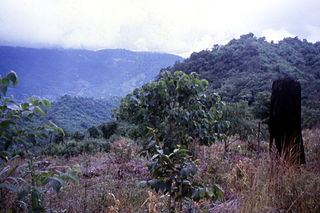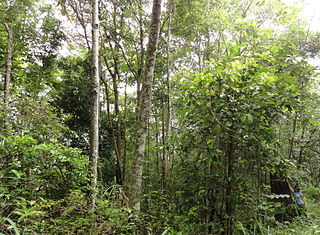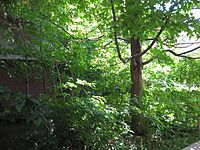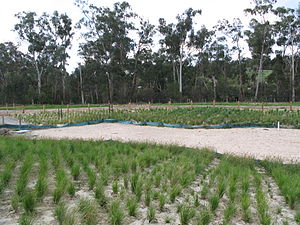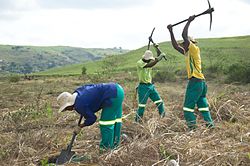In
the 1980s, conservation organizations warned that, once destroyed,
tropical forests could never be restored. Thirty years of restoration
research now challenge this: a) This site in Doi Suthep-Pui National
Park, N. Thailand was deforested, over-cultivated and then burnt. The
black tree stump was one of the original forest trees. Local people
teamed up with scientists to repair their watershed.
Fire prevention, nurturing natural regeneration and planting framework
tree species resulted in trees growing above the weed canopy within a
year.
After 12 years, the restored forest overwhelmed the black tree stump.
Forest restoration is defined as “actions to re-instate
ecological processes, which accelerate recovery of forest structure,
ecological functioning and biodiversity levels towards those typical of climax forest” i.e. the end-stage of natural forest succession.
Climax forests are relatively stable ecosystems that have developed the
maximum biomass, structural complexity and species diversity that are
possible within the limits imposed by climate and soil and without continued disturbance from humans.
Climax forest is therefore the target ecosystem, which defines the
ultimate aim of forest restoration. Since climate is a major factor that
determines climax forest composition, global climate change may result
in changing restoration aims.
Forest restoration is a specialized form of reforestation, but it differs from conventional tree plantations in that its primary goals are biodiversity recovery and environmental protection.
Scope
Forest
restoration may include simply protecting remnant vegetation (fire
prevention, cattle exclusion etc.) or more active interventions to
accelerate natural regeneration, as well as tree planting and/or sowing seeds (direct seeding)
of species characteristic of the target ecosystem. Tree species planted
(or encouraged to establish) are those that are typical of, or provide a
critical ecological function in, the target ecosystem. However,
wherever people live in or near restoration sites, restoration projects
often include economic species amongst the planted trees, to yield
subsistence or cash-generating products.
Forest restoration is an inclusive process, which depends on
collaboration among a wide range of stakeholders including local
communities, government officials, non-government organizations,
scientists and funding agencies. Its ecological success is measured in
terms of increased biological diversity, biomass, primary productivity, soil organic matter and water-holding capacity, as well as the return of rare and keystone species,
characteristic of the target ecosystem. Economic indices of success
include the value of forest products and ecological services generated
(e.g. watershed protection, carbon storage etc.), which ultimately
contribute towards poverty reduction. Payments for such ecological services (PES) and forest products can provide strong incentives for local people to implement restoration projects.
Opportunities for forest restoration
Demonstration forest restoration plot, SUNY-ESF, Syracuse, NY
Forest restoration is appropriate wherever biodiversity recovery is
one of the main goals of reforestation, such as for wildlife
conservation, environmental protection, eco-tourism or to supply a wide
variety of forest products to local communities.
Forests can be restored in a wide range of circumstances, but degraded
sites within protected areas are a high priority, especially where some
climax forest remains as a seed source within the landscape. Even in
protected areas, there are often large deforested sites: logged over
areas or sites formerly cleared for agriculture. If protected areas are
to act as Earth’s last wildlife refuges, restoration of such areas will
be needed.
Many restoration projects are now being implemented under the umbrella of “forest landscape restoration” (FLR),
defined as a “planned process to regain ecological integrity and
enhance human well-being in deforested or degraded landscapes”. FLR
recognizes that forest restoration has social and economic functions. It
aims to achieve the best possible compromise between meeting both
conservation goals and the needs of rural communities.
As human pressure on landscapes increases, forest restoration will most
commonly be practiced within a mosaic of other forms of forest
management, to meet the economic needs of local people.
A recent focal area for forest restoration efforts is within the
urban context, where both people and biodiversity will benefit, however
this context presents unique challenges.
Natural regeneration
Tree
planting is not always essential to restore forest ecosystems. A lot
can be achieved by studying how forests regenerate naturally,
identifying the factors that limit regeneration and devising methods to
overcome them. These can include weeding and adding fertilizer around
natural tree seedlings, preventing fire, removing cattle and so on. This
is "accelerated" or "assisted" natural regeneration. It is simple and cost-effective, but it can only operate on trees that are already present, mostly light-loving pioneer species.
Such tree species are not usually those that comprise climax forests,
but they can foster recolonization of the site by shade-tolerant climax
forest tree species, via natural seed dispersal from remnant forest.
Because this is a slow process, biodiversity recovery can usually be
accelerated by planting some climax forest tree species, especially
large-seeded, poorly dispersed species. It is not feasible to plant all
the tree species that may have formerly grown in the original primary
forest and it is usually unnecessary to do so, if the framework species method can be used.
Post-fire regeneration
In
large parts of the world, forest fires cover a heavy toll on forests.
That can be because of provoked deforestation in order to substitute
forests by crop areas, or in dry areas, because of wild fires occurring
naturally or intentionally. A whole section of forest landscape
restoration in linked to this particular problem, as in many cases, the
net loss of ecosystem value is very high and can open the drop to an
accelerated further degradation of the soil conditions through erosion
and desertification.
This indeed has dire consequences on both the quality of the habitats
and their related fauna. Nevertheless, in some specific cases, wild
fires do actually allow to increase the biodiversity index of the burnt area, in which case the Forest Restoration Strategies tend to look for a different land-use.
Forest restoration projects
Ashland Forest Resiliency Stewardship Project
The Ashland Forest Resiliency Stewardship Project (AFR)
is a decade long, science-based project launched in 2010 with the
intent of reducing severe wildfire risk, but also protecting water
quality, old-growth forest, wildlife, people, property, and the overall
quality of life within the Ashland watershed. The primary stakeholders
in this cooperative restoration effort are the U.S. Forest Service, the
City of Ashland, Lomaktsi Restoration Project, and the Nature
Conservancy.
The project was launched with initial funding from the Economic
Recovery stimulus, and has more recently received funding from the
Forest Service Hazardous Fuels program and the Joint Chiefs Landscape
Restoration Partnerships program to back the project through 2016.
Located in the dry forests of southern Oregon, the threat of
wildfire is a reality for land managers and property owners alike. The
boundaries of the city of Ashland intersect with the surrounding forest
in what is referred to as the wildland-urban interface (WUI).
Historically, the forests of this region experienced a relatively
frequent fire return interval, which prevented buildup of heavy fuel
loads.
A century of fire exclusion and suppression on federal lands in the
Pacific Northwest has led to increased forest density and fuel loads,
and thus a more persistent threat of devastating wildfire.
The AFR project has implemented restoration techniques and prescriptions that aim to replicate the process of ecological succession
in dry, mixed-conifer forests of the Pacific Northwest. The approach
involves a combination of fuels reduction, thinning small-diameter
trees, and carrying out prescribed burns. Priority is given to
maintaining ecological function and complexity by retaining the largest
and oldest trees, preserving wildlife habitat and riparian areas, and
protecting erodible soils and maintaining slope stability.
Since its inception in 2010, the AFR project has completed
restoration work on 4,000 of the 7,600 acres slated for the project. The
project has provided educational experience to over 2,000 students and
has benefitted the local community by creating jobs and providing
workforce training. Currently, helicopter logging operations are
thinning 1,100 acres of the watershed while controlled burning
operations take place as air quality conditions allow.
Forest landscape restoration
Forest
landscape restoration (FLR) is defined as “a planned process to regain
ecological integrity and enhance human well-being in deforested or degraded landscapes”.
It comprises tools and procedures to integrate site-level forest
restoration actions with desirable landscape-level objectives, which are
decided upon via various participatory mechanisms among stakeholders.
The concept has grown out of collaboration among some of the world's
major international conservation organizations including the International Union for Conservation of Nature (IUCN), the World Wide Fund for Nature (WWF), the World Resources Institute and the International Tropical Timber Organization (ITTO).
Aims
The concept of FLR was conceived to bring about compromises between meeting the needs of both humans and wildlife, by restoring
a range of forest functions at the landscape level. It includes actions
to strengthen the resilience and ecological integrity of landscapes and
thereby keep future management options open. The participation of local
communities is central to the concept, because they play a critical
role in shaping the landscape and gain significant benefits from
restored forest resources. Therefore, FLR activities are inclusive and
participatory.
Desirable outcomes
The
desirable outcomes of an FLR program usually comprise a combination of
the following, depending on local needs and aspirations:
- identification of the root causes of forest degradation and prevention of further deforestation,
- positive engagement of people in the planning of forest restoration, resolution of land-use conflicts and agreement on benefit-sharing systems,
- compromises over land-use trade-offs that are acceptable to the majority of stakeholders,
- a repository of biological diversity of both local and global value,
- delivery of a range of utilitarian benefits to local communities including:
- a reliable supply of clean water,
- environmental protection particularly watershed services (e.g. reduced soil erosion, lower landslide risk, flood/drought mitigation etc.),
- a sustainable supply of a diverse range of forest products including foods, medicines, firewood etc.,
- monetary income from various sources e.g. ecotourism, carbon trading via the REDD+ mechanism and from payments for other environmental services (PES)
Activities
FLR
combines several existing principles and techniques of development,
conservation and natural resource management, such as landscape
character assessment, participatory rural appraisal, adaptive management
etc. within a clear and consistent evaluation and learning framework.
An FLR program may comprise various forestry practices on different
sites within the landscape, depending on local environmental and
socioeconomic factors. These may include protection and management of
secondary and degraded primary forests, standard forest restoration
techniques such as "assisted" or "accelerated" natural regeneration (ANR) and the planting of framework tree species to restore degraded areas, as well as conventional tree plantations and agroforestry systems to meet more immediate monetary needs.
The IUCN hosts the Global Partnership on Forest Landscape Restoration, which co-ordinates development of the concept around the world.
In 2014, the Food and Agricultural Organization of the United Nations established the Forest and Landscape Restoration Mechanism. The Mechanism supports countries to implement FLR as a contribution to achieving the Bonn Challenge - the restoration of 150 million hectare of deforested and degraded lands by 2020 - and the Convention on Biological Diversity Aichi Biodiversity Targets - related to ecosystem conservation and restoration.
In partnership with the Global Mechanism of the United Nations Convention to Combat Desertification, FAO released two discussion papers on sustainable financing for FLR in 2015. Sustainable Financing for Forest and Landscape Restoration: The Role of Public Policy Makers provides recommendations and examples of FLR financing for countrues. Sustainable Financing for Forest and Landscape Restoration - Opportunities, challenges and the way forward provides an overview of funding sources and financial instruments available for FLR activities.

